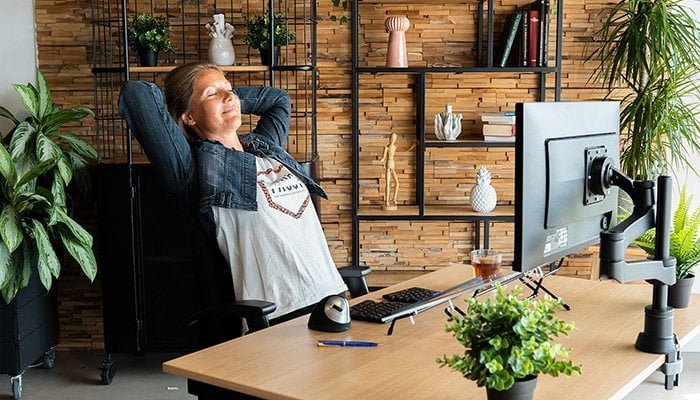In recent years, offices have rapidly been fitted out with sit-stand desks and other tools to help people work healthily. Now, because of corona, many are forced to work at home. And that has pros and cons.
We conducted a survey of over a hundred home workers in spring 2020. This random group of home workers was asked about the advantages and disadvantages of working at home. They were asked questions on workplace design, work-related complaints, productivity and break behaviour. This always involved a comparison between working at home and working in the office.
People see both advantages and disadvantages of working at home
Working at home brings several advantages. The survey found that respondents see the lack of travel time as the biggest advantage of working from home. They also experience more flexibility and freedom to plan the working day. Many respondents experience more peace and less distraction (especially from colleagues) at home. Finally, they reported experiencing more safety at home because of the coronavirus.
But unfortunately, there are also disadvantages to working from home. The survey shows that many respondents are distracted at home during the working day (especially those with children). They also see the disadvantage of having fewer social contacts with colleagues. Face-to-face meetings or catching up during a break is out of the question. Finally, a major disadvantage is that the home workplace is not ergonomically designed.
More productive at home than in the office
Over 40 per cent of respondents say they are more productive at home than in the office, while 27 per cent say they are more productive in the office. The rest of those surveyed experience no difference.
More flexibility and freedom at home, but fewer breaks
Most respondents reported experiencing more flexibility and freedom at home. Yet the survey found that, on average, people take fewer breaks during the working day at home than at the office.
For both office and home working, it is notable that only 50 per cent take a lunch break. Employees also take less micro-breaks. These are the short vital breaks (micro-breaks) needed to keep the body’s blood circulation going. This is the case both when working at home and in the office. Only 5 per cent of respondents take a short break every 10 minutes to change positions.
More physical complaints at home
The results don’t lie: over 24 per cent of respondents said they regularly to continually suffer work-related physical complaints at home: in neck, shoulders, back, arms, wrists, hands or headaches. While in the office, this is less than 9 per cent! The group of home workers without complaints is only 20 per cent.
Ergonomics neglected when working at home
When asked about furniture and aids present at the home workplace, it was noticed that only 3.5 per cent of respondents have the monitor at eye level. This means that almost everyone keeps their head in an unnatural position while working at home. Especially when looking down a lot, this can be very stressful for the neck and lead to neck pain or headaches.
Most interviewees indicated that the office workplace is better equipped than the home workplace. For example, less than 50 per cent have an adjustable office chair at home, while almost 85 per cent have a good chair at the office.
When asked “What is still missing to be able to work well (ergonomically) at home?”, most respondents said they would like to have more ergonomic furniture for working at home. Many respondents also see a screen riser (such as a laptop stand) as a necessary addition to the home office.
Healthy working with an ergonomic home office
The survey shows that people experience significantly more physical complaints now that they work from home. Especially the lack of an ergonomic workplace plays an important role in this. While an ergonomically designed workplace stimulates people to adopt a good working posture and thus helps them to work healthily.

Tips for healthy working at home
Want to make do with what you have and still work healthily at home? These 5 tips will take you a long way.
Support your body
Sit well back in the chair with your back against the backrest and have your forearms supported while the shoulders droop.
Work in an upright posture
Place the screen straight in front of your body and put the top of the screen at eye level. For your laptop, use a laptop riser and place documents between the keyboard and screen.
Avoid reaching for the mouse
Place keyboard and mouse close to your body and also put the phone within reach.
Avoid small repetitive movements
Typing is healthier than mousing, so use keyboard shortcuts as much as possible. Move the mouse from the whole arm rather than from the wrist. Use a separate keyboard and mouse when working on a laptop.
Ensure relaxation and sufficient exercise
Limit the number of hours of screen work and take regular (micro) breaks. The advice is to change your posture and relax/stretch your muscles every 10 minutes. Alternate sitting regularly with standing and walking.
This research was published 24 April 2020 on Arbo online, the Dutch Health and Safety Act website.


